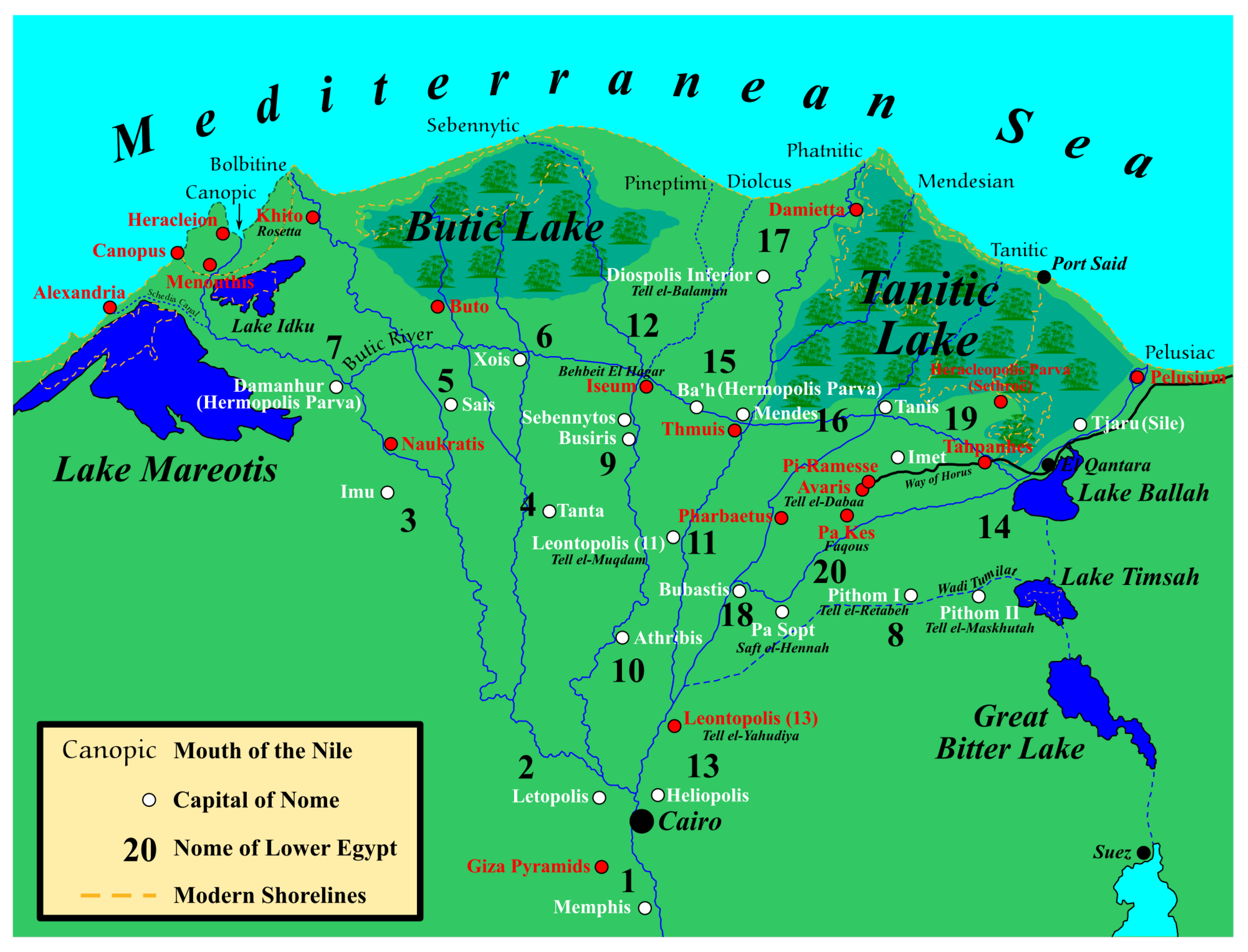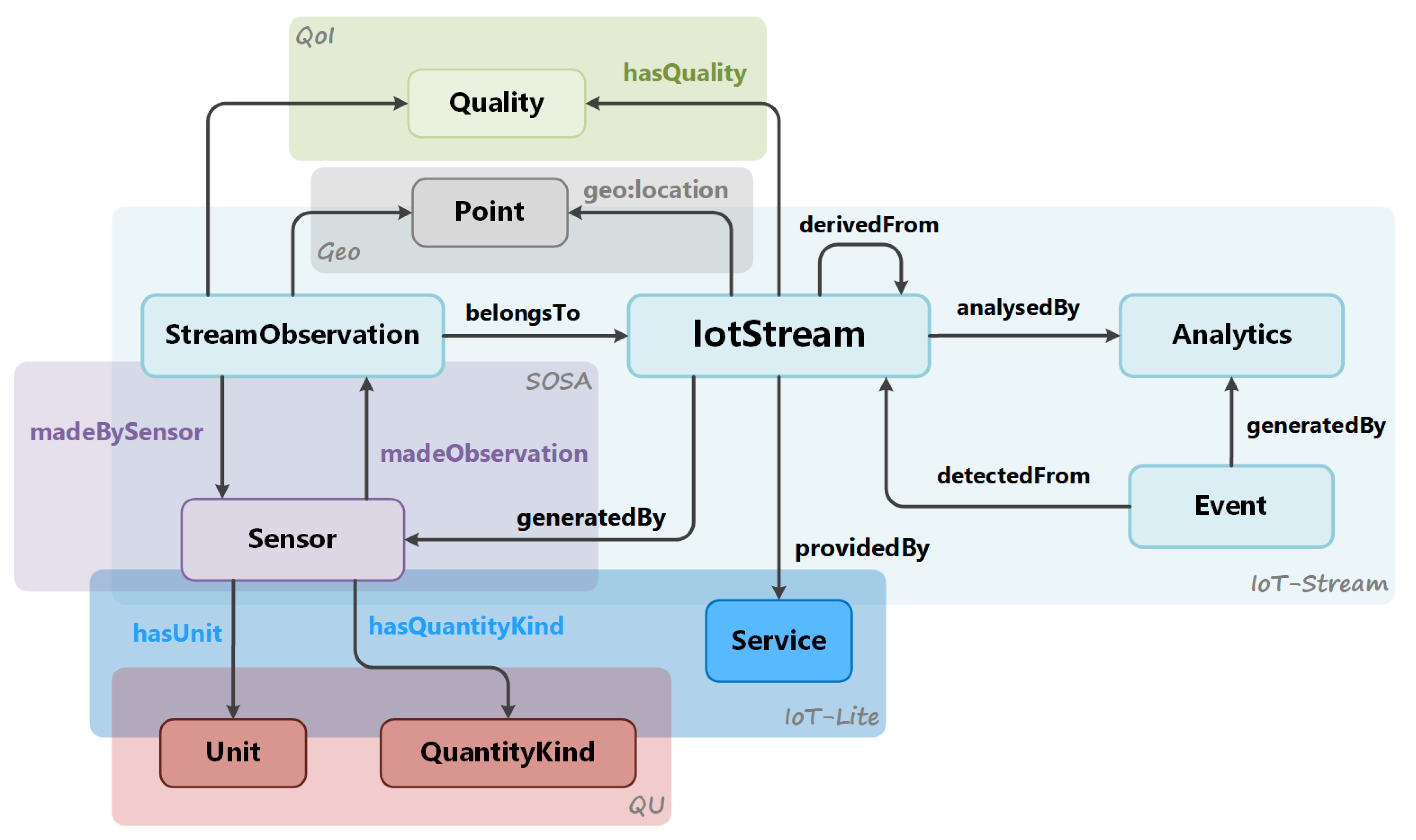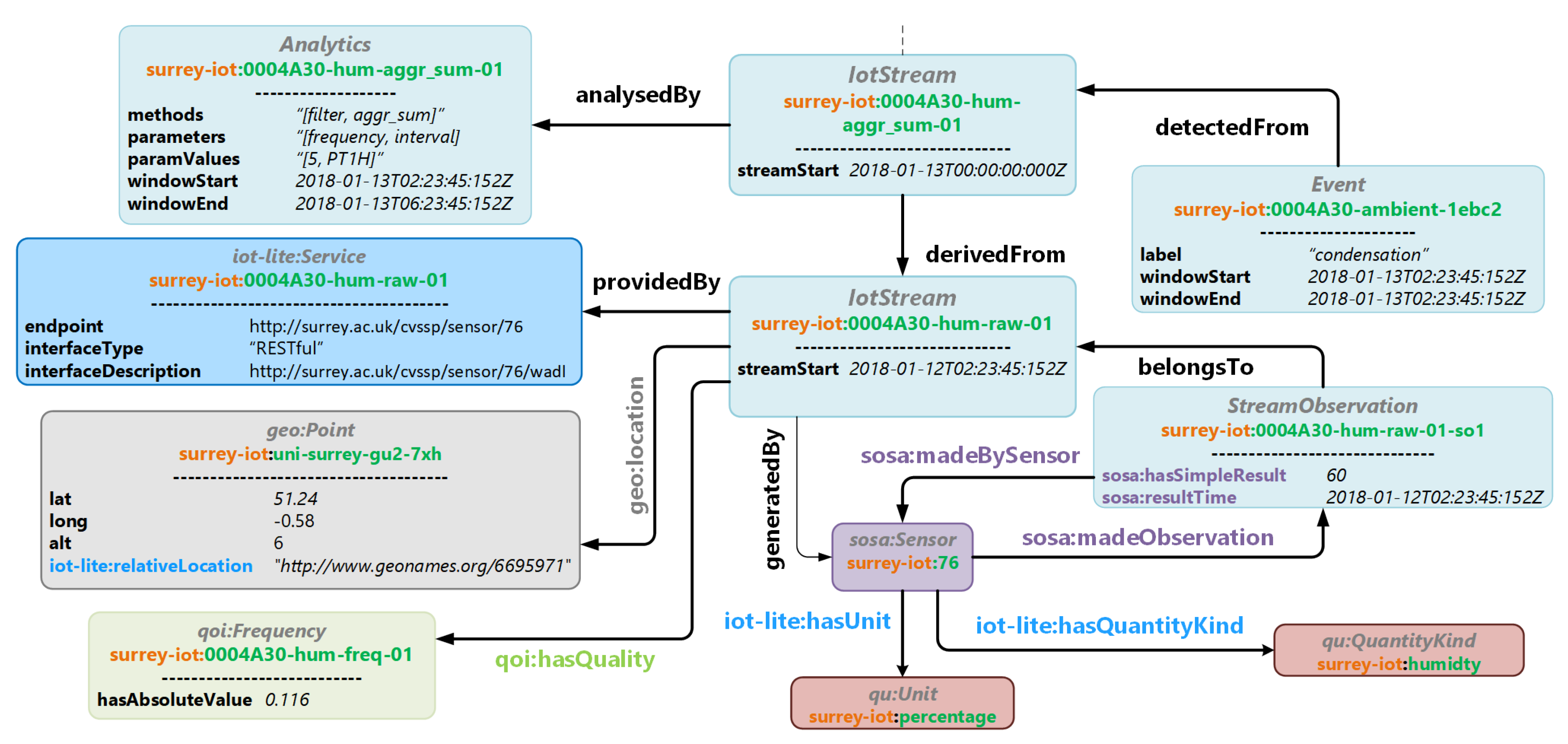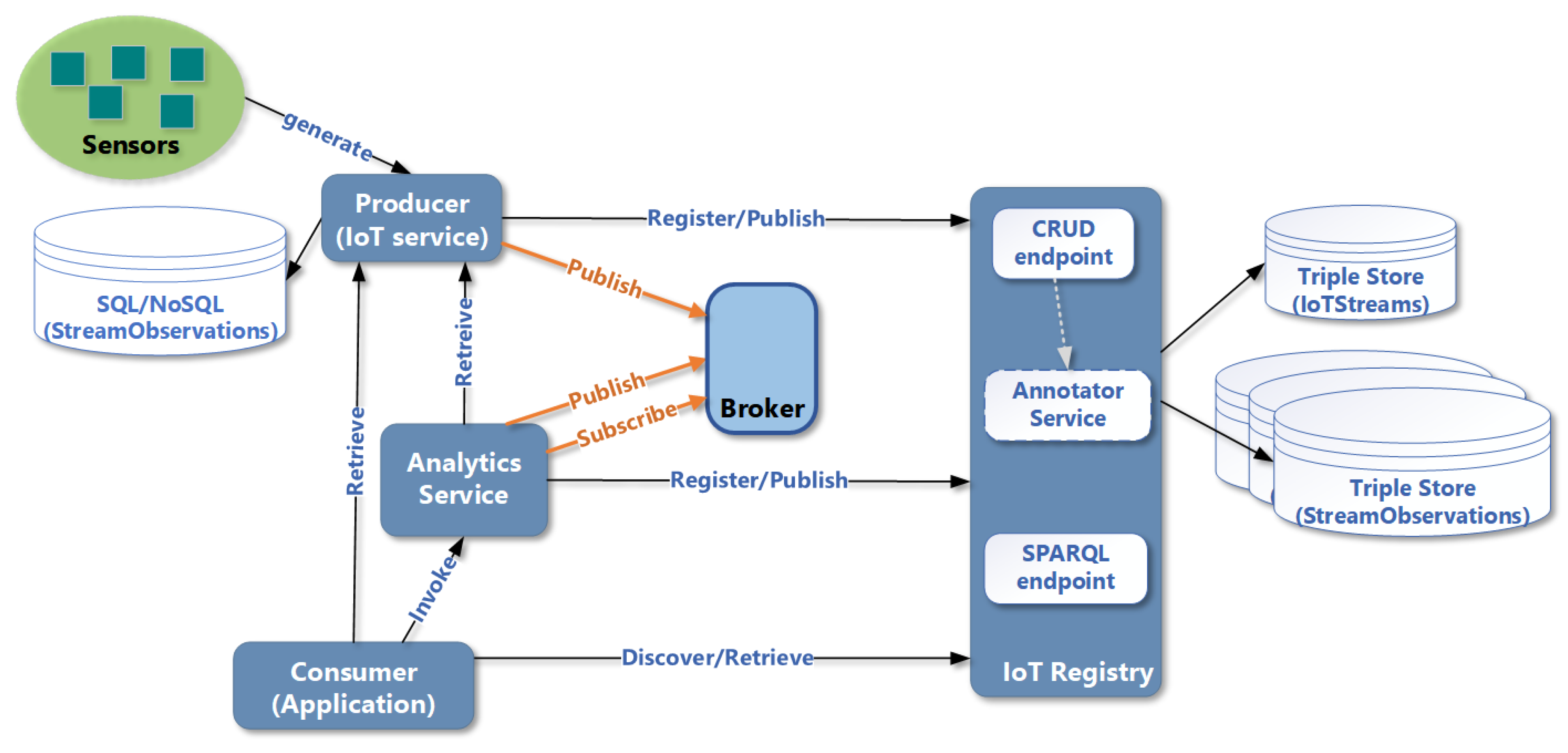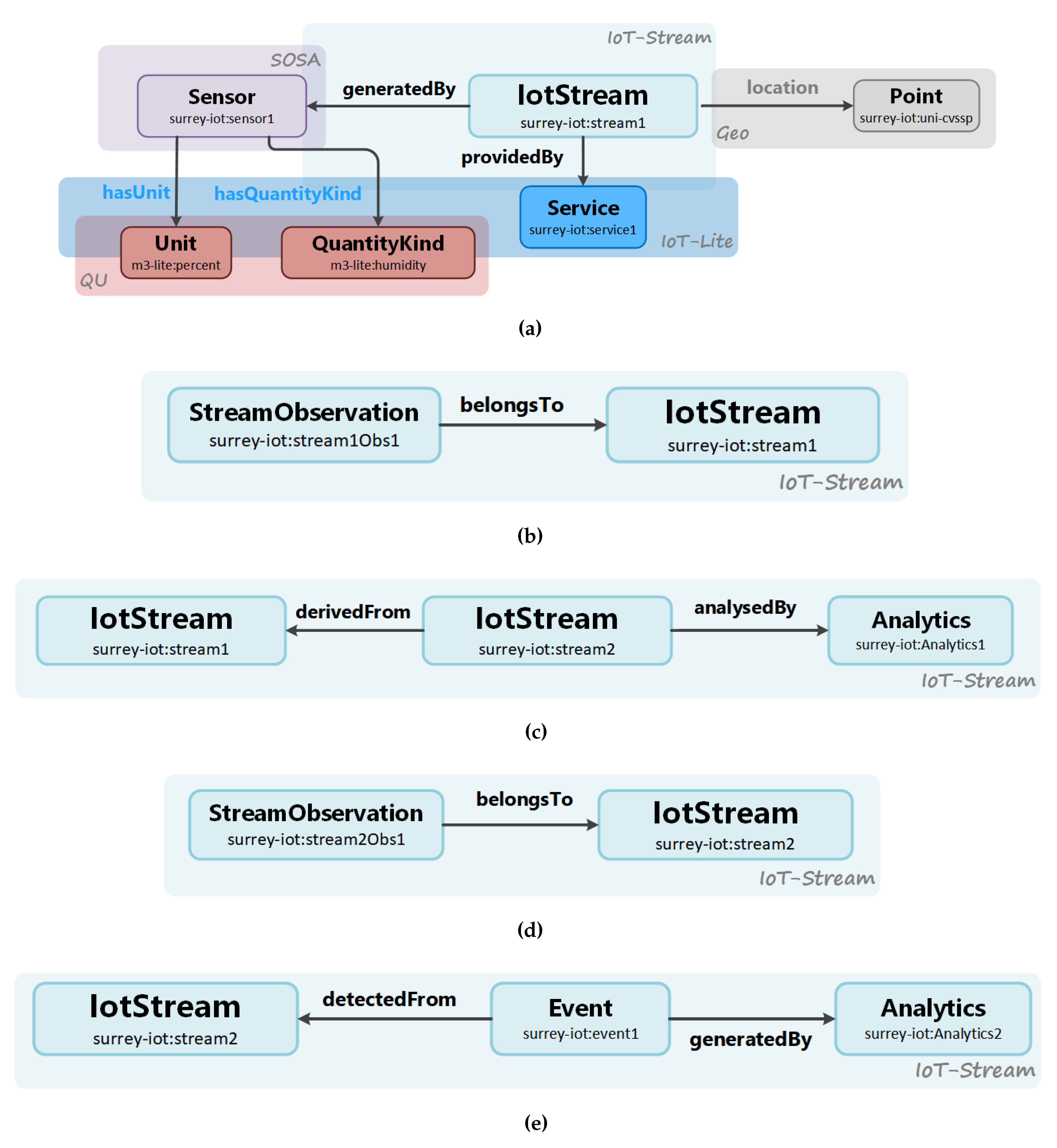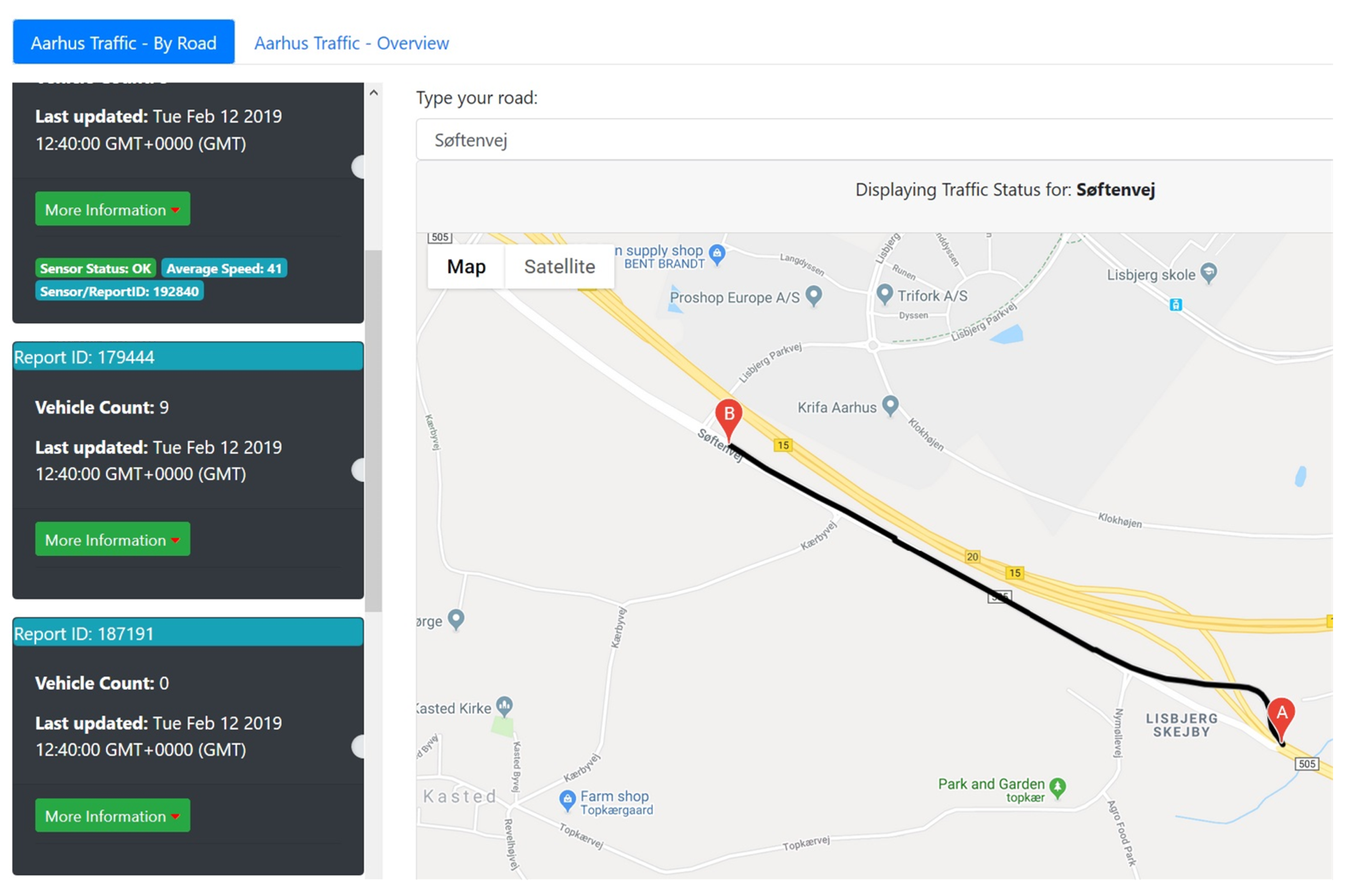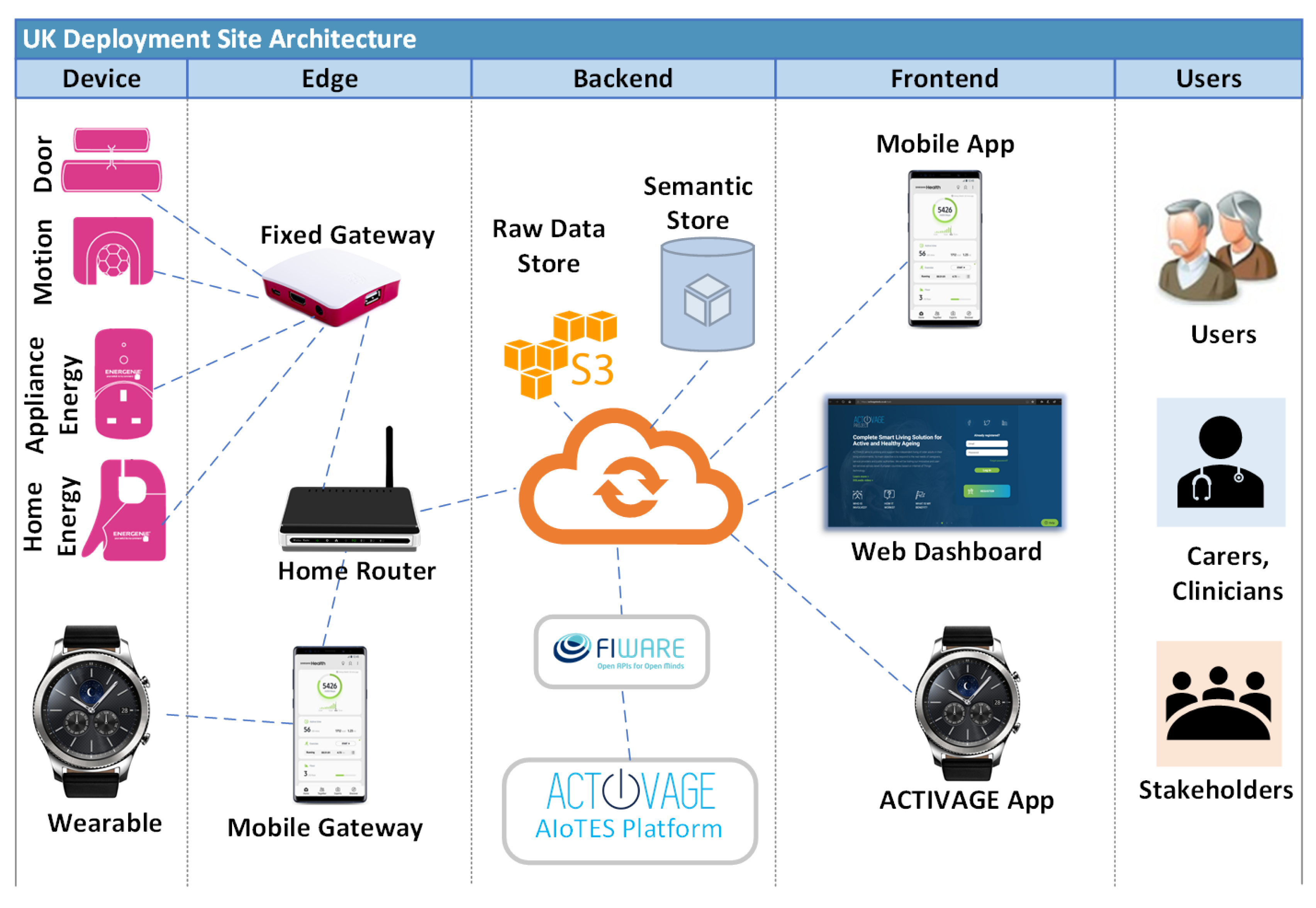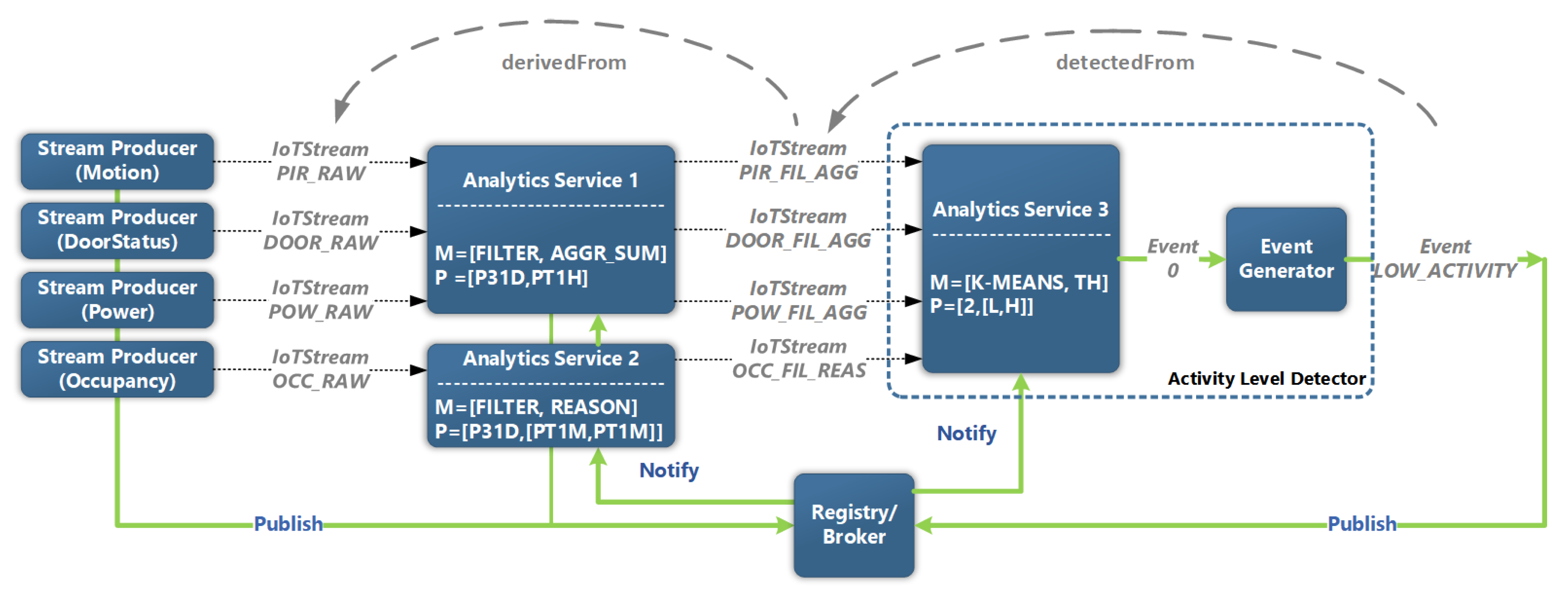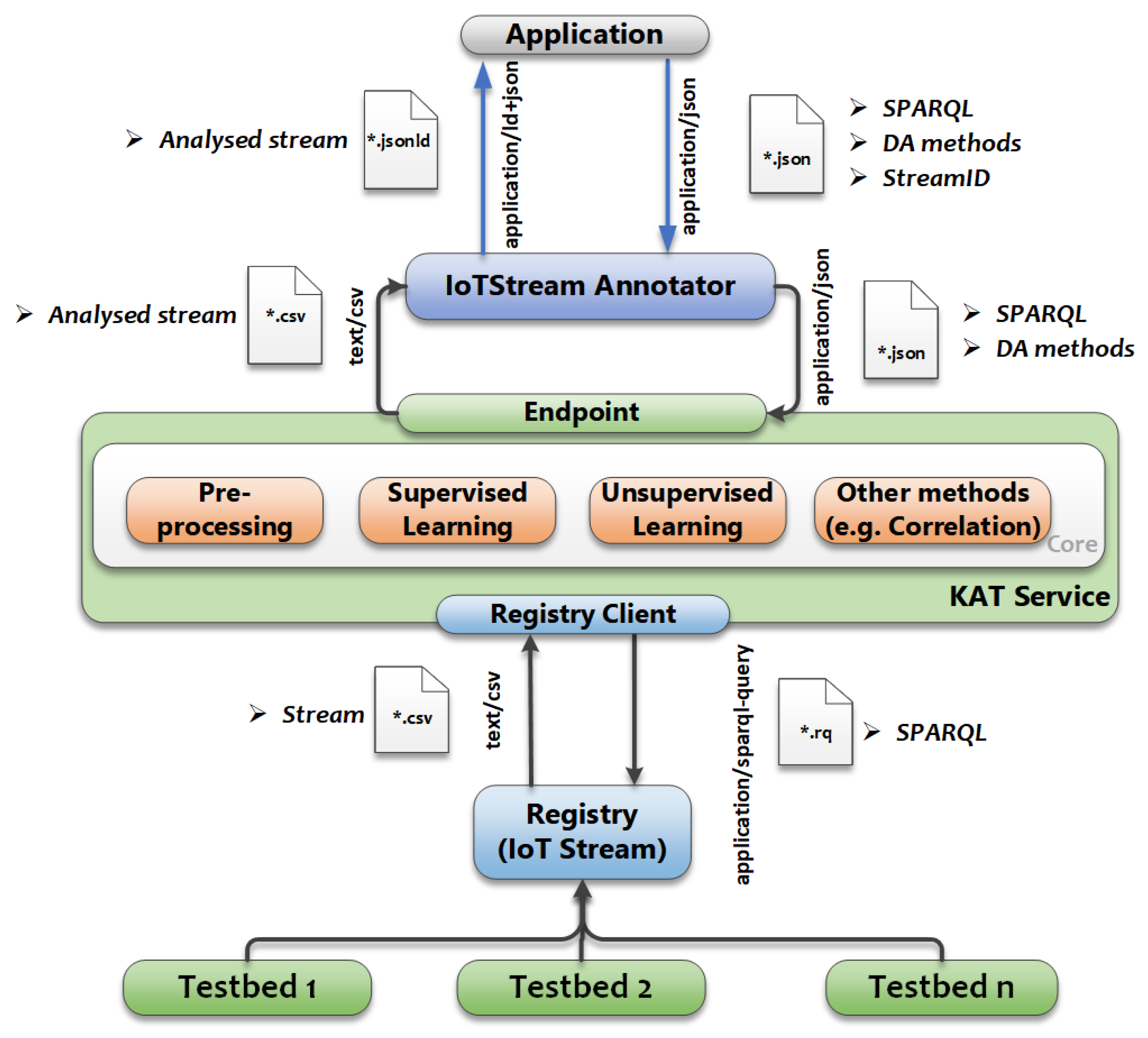1. Introduction
Internet of Things (IoT) has introduced radical changes in the way data are processed. The amount of IoT data, the velocity of change, variety of sources and formats of said IoT data implies new challenges to process and interoperate between heterogeneous data sources and formats. Especially in large-scale IoT solutions, new solutions are being proposed in order to deal with the big IoT data.
Semantics is one the most used solutions to overcome the heterogeneity of IoT data sources and formats. Semantics provide common information models with which the services using heterogeneous sources of information could interoperate using the same concepts and relationships between concepts. Examples of these solutions include information models describing IoT devices, services, types, and units of data, etc., such as the models in [
1,
2,
3,
4].
Some years ago, the main bout of the ontologies were to describe in detail the real world, annotating as much information as possible to represent the real world in the ontology. However, with the growth of the number of sensors and data, the time to annotate and query the ontologies has become a bottleneck in the (quasi) real-time processing of data coming from the IoT environments. Therefore, having lightweight models with a minimum number of concepts and relationships between concepts, enough to allow the regular searches and crawling of IoT data streams, will improve the processing time of the IoT data. In the last few years, some researchers have conceived and applied the idea of lightweight information models in the field of IoT, such as IoT-Lite [
5], and the Semantic Sensor Network model (SSN) [
6], which is a standard de-facto for modelling sensors. SSN has recently published a lightweight ontology, SOSA (Sensor, Observation, Sample and Actuation) [
7], which has become the core ontology of the new version of the compendium of ontologies, SSN. However, the lightweight models mentioned, IoT-Lite and SOSA, are centred around devices, but do not pay enough attention to the IoT data streams. For stream annotation, there is a lack of lightweight models. Some models provide detailed stream annotations, such as SAO (Stream Annotation Ontology) [
8]. However, these detailed annotations added some delay in processing time during data stream acquisition and processing, making it difficult to operate with (near) real-time applications.
In light of this, we propose IoT-Stream, a lightweight semantic model for stream data annotation, which is centred around the concept of an IoT-Stream, and extends the SOSA ontology (and by extension SSN). The main idea behind IoT-Stream is the simplicity of the information model, and especially the individual streams, which are the heavier part of the annotations, as they represent most of the information annotated. Therefore, each stream observation in our proposal is composed of only a value and a timestamp. Hence, we have segregated all the metadata needed for searching and crawling purposes, but not required for (quasi) real-time data processing. Furthermore, our proposal allows for annotating raw data as well as processed data, and both of them could be annotated as streams and could be kept lightweight. For instance, a sensor generates one data value per minute, and we could annotate individually this raw data. However, the applications using the information model could not require such fine granularity and using data every ten minutes will be enough. In that case, we could apply some data mining algorithms to aggregate the raw data in windows of ten minutes. For example, we could use SAX (Symbolic Aggregate Approximation) to aggregate the raw data, and annotate with IoT-Stream the processed data stream. Both the raw stream and the processed stream are lightweight because both streams annotate only the observation value and either the timestamp (for the raw data stream) or the window interval (for the processed data stream). For searching/crawling purposes, we also attached metadata outside of the stream observations such as applied algorithm and its parameters with their values.
Having good semantic models and creating ontologies is not enough. Semantics are not the end-product, they are only models to be used by applications, so the focus of the ontology design should be on extending the models with effective methods, tools, and APIs (Application Programming Interfaces) to handle and process the ontologies. Queries and analytics should be able to effectively use these semantics [
9]. In order to facilitate the adoption of semantics, we also proposed a reference system, with the necessary entities to annotate, analyze, and query the stream data. Later in the paper, we also describe some successful use-cases, tools, and applications using IoT-Stream and the system instantiation used in each of the use cases.
The remainder of the paper is organized as follows.
Section 2 describes the related work.
Section 3 introduces the IoT-Stream ontology, and how it was created and why.
Section 4 provides an example of a system architecture for dealing with annotated data with our model in IoT scenarios. This section will help developers to adopt and reproduce our ontology and scenarios or similar ones.
Section 5 introduces several case scenarios that have been successfully used and that illustrates the semantic annotation of sensor stream data with our model.
Section 6 details several applications which could be used in conjunction with our model and that could help in the adoption and automation of the stream processing. Finally,
Section 7 concludes the paper and describes the future work.
2. Related Work
Semantic models representing stream annotations are scarce. To represent IoT data streams, we need concepts that represent devices, location, time, quantity units, values, and streams. In the description of devices, there are some models to represent sensors and their observations. The most representative model is the SSN ontology which describes sensors with their properties, systems, deployments, stimuli, and observations [
6]. The SOSA ontology is a lightweight core for SSN that provides concepts for sensors, observation values, and features of interest [
7]. IoT-Lite is another lightweight model for IoT concepts with the aim of fast annotation, processing, and semantic querying time. IoT-Lite was inspired by the IoT-A reference model [
10] which defined core concepts for the IoT, namely Resources, Entities, and Services. It instantiates and extends Device and Sensor concepts from SSN [
11]. The focus of IoT-Lite, SOSA, and SSN is more on sensing devices and is appropriate for sensor discovery, lacking specific concepts for stream annotation and aggregation. For example, Le-Phuoc et al. [
12] create a graph of things with spatial and temporal annotations using SSN and in a use case representing flights in a map to annotate streams. However, they have just annotated individual values, not aggregated values. Furthermore, each annotation has several classes and properties; hence, the annotation and querying require a processing time which could be improved with a lightweight annotation focusing on stream requirements.
There are some location models, such as Geo (
https://www.w3.org/2003/01/geo/) that helps in searching for IoT devices. Geo is a popular model that represents location data in RDF, and it does not try to tackle many of the matters covered in the professional Geographic Information System (GIS) world. Instead, the ontology offers just a few basic simple terms that can be used in RDF when there is a need to describe latitudes, longitudes, and altitudes. The use of RDF as a carrier for latitude, longitude, and altitude simplifies the capability for cross-domain data mixing, as well as describing entities that are positioned on the map (e.g., carrying out geospatial queries for Sensors, Deployments, Platforms, or Systems). GeoSPARQL is a standard for the representation and querying of geospatial linked data for the Semantic Web from the Open Geospatial Consortium (OGC) [
13]. GeoSPARQL defines location-related concepts to facilitate sensor discovery as per spatial requirements. GeoJSON (
https://tools.ietf.org/html/rfc7946) is a geospatial data interchange format based on JSON. It describes numerous types of JSON objects and the way they are joined to represent data about geographic features, their properties, and their spatial extents. GeoJSON supports a range of geometry types ranging from
Point,
LineString,
Polygon,
MultiPoint,
MultiLineString, and
MultiPolygon.
The Time ontology (
https://www.w3.org/TR/2017/REC-owl-time-20171019/) is a well-known and widely used semantic model to represent time. It has a vocabulary for representing information about topological (ordering) relations, duration, and temporal position (i.e., date–time information). Time can be expressed using conventional clock, Unix-time, geologic time, and other reference systems. For duration, it can also use different systems—for example, Gregorian calendar as in [
14]; this ontology has been extended in the last versions with various temporal concepts, such as instants and intervals, and interval relationships. These concepts were present as well in the TimeLine ontology [
15], together with concepts of timelines (e.g., universal or discrete). These time ontologies have been used to annotate streams and have inspired the querying of stream data.
There are also some ontologies to provide quantities, units, dimensions and values. The QU ontology (
https://www.w3.org/2005/Incubator/ssn/ssnx/qu/qu-rec20.html) is one of the well-known ontologies in this field. Qu ontology has been developed to support different Systems Modelling Language (SysML) users [
16].
Another important aspect of stream data annotation is the Quality of Information (QoI) because faulty data can have costly consequences [
17]. When talking about Quality of Information, categories or metrics are important to describe the details. There are five common metrics: Completeness, Correctness, Concordance, Currency, Plausibility [
18], and Security [
19]. In the CityPulse project (
http://www.ict-citypulse.eu/page/), they extend the ontology and used five categories; Timeliness, Cost, Accuracy, Communication, and Security, each with a collection of sub-metrics. The major problem in the model is lack of ground truth in Correctness which has been addressed in [
20] with spatio-temporal, causality, and outcome evaluation.
The previously mentioned ontologies could help in the annotation of stream data, but do not tackle all the concepts needed for this type of data, and missed essential concepts, such as aggregation of streams that could leverage the processing time when querying stream data.
There are few ontologies representing stream data. One representative is SAO. SAO has been built on top of some well-known ontologies to represent IoT data streams: TimeLine [
15], PROV-O [
21], SSN [
6], and Event Ontology [
15].
StreamData,
StreamEvent,
StreamAnalysis,
Observation,
Sensor, and
Segment concepts enable this ontology to describe temporal concepts accurately. With
StreamData class, SAO can provide a stream data as a temporal point or segment and it describes the output of the observation as an event with
StreamEvent class [
8]. We propose to enhance SAO by reducing the triples needed for querying the stream data.
Recently, the RDF Stream Processing Community Group has attempted to define a common model for producing, transmitting, and continuously querying RDF Streams. Their focus is on extending RDF and SPARQL to represent and query stream data. Their solution is based heavily in previous solutions for querying stream data, such as SPARQLstream [
22,
23], C-SPARQL [
24], EP-SPARQL [
25], Instants [
26], CQUEL [
27], or STARQL [
28] that allows for a uniform querying of both streaming and static data. Although these extensions of SPARQL for streams are highly appealing and need to be used by any stream annotation model, like the one we propose here, they do not focus on the annotation of the streams, but only on the querying. In the field of stream annotation models, the RDF Stream Processing Community Group is studying how to modify RDF to facilitate the representation of streams. Thus far, what they have published is to represent an RDF stream as a sequence of time-annotated graphs <g [t]>, where g is an RDF graph and t is a timestamp [
29]. This approach has already been used by Siemens and in the European project Optique to annotate streams [
30,
31], using the query language STARQL. The Optique platform is a complete platform, including a deployment module, BootOX for ontology and mapping bootstrapping, the query language STARQL, a backend, ExaStream, which process the data, and a query interface, OptiqueVQS [
32], allowing to write queries for non-experts, without knowledge of the query syntax. This work is an excellent solution, which can be used together with our light ontology solution to improve the performance of the annotations and queries. However, this solution involves the modification of the standard RDF, and therefore the adaptation of the involved reasoners (including triple stores) and tools, which means that at the present moment some reasoners would not work with this RDF notation. To take advantage of the current tools, we opt for a solution that does not imply the modification of RDF—although in the future our proposal could be easily modified to accept the new version of RDF notation upon its acceptance as standard, and our model could support both standards.
3. IoT-Stream Ontology
3.1. Vision, Design, and Best Practices
The vision for an ontology for IoT stream data can be described through an analogy where stream data can be compared to rivers and canals as shown in
Figure 1 (
https://commons.wikimedia.org/wiki/File:Map_of_Lower_Egypt.svg). As can be seen from the bottom of the figure, these waterways can branch out and feed to one or more other streams, all of which are destined to a (data) lake or sea. Streams that are created can be a result of some form of processing, such as in the case of water supply and sewage systems. During processing, analysis can be applied to detect changes, abnormalities, patterns of interest, events, or even some form of treatment, as is the case with data streams.
To reflect this into the design of the ontology, concepts of stream derivation and analysis need to be defined. Since IoT data streams are expected to produce observations on the scale of big data, it is imperative to maintain a light approach to defining the stream observations concepts, and to segregate them from descriptions relating to the IoT stream as a whole. For an ontology to be effective for adoption, the development of an ontology must be have a foundation with well-established best practices, such as those defined in the ontology creation guide [
33]. Here, the first consideration is to define the ontology’s domain and scope, which in this case revolves around the concept of data streams produced by IoT sources, with a focus on concepts to support data analysis, event detection and provenance. From extensive work on previous projects focusing on defining concepts for IoT entities and data, such as in [
8,
34,
35,
36], a common challenge was a trade-off between expressiveness in data annotation, persistence size, and efficiency in querying. For IoT stream data and analysis, the scope must be focused on how their consumption will work in a scalable system. The next consideration is to adopt existing concepts from other ontologies that can enrich the model with metadata that is useful for describing the main concept—in this case, the IoT Stream. Here, concepts relating to space, time, theme, device association, service exposure, and data quality are highly relevant, which are available and well-established in the IoT community. Its adoption is explained in
Section 3.3. The third consideration is what terms are to captured in the ontology. Regarding streams and stream data, the time instant or interval at which the observation was made is important. Regarding the value, it should be simple but flexible as observation formats can vary between systems. For terms relating to data analytics applied to streams, terms such the methods and parameters used in a particular technique are needed. An important output of analysis are events and alerts that are detected from the streams, and hence labels and the temporal aspects should be captured. The fourth consideration is to adopt a hierarchy for the classes defined. As the intention for this ontology is to be lightweight, the only focus here would be on the stream observation. The SSN ontology provides a concept for observations and meets the basic requirements defined earlier, and so it has been adopted and extended to cater to the nature of stream observations, as explained in
Section 3.2.
Another aspect to take into account is that the ontology should reflect principles adopted in ontologies that have been highlighted by standardization bodies for the application of best practices, such as the W3C Good Ontologies (
http://www.w3.org/wiki/Good_Ontologies). These principles relate to the quality of the associated documentation of the ontology, and that it is an Internationalized Resource Identifier (IRI) is dereferenced. It should also demonstrate adoption by data producers for annotation, and is supported by existing tools, which is presented in
Section 5 and
Section 6. Once all of these aspects are applied, an information model for IoT stream data can be formulated.
3.2. Information Model
The principal information model focuses on modelling stream observations, its analysis and events that are detected from it, which are captured in four classes. These classes reflect the concepts of an
IotStream, a
StreamObservation, an
Analytics process and an
Event. As depicted in
Figure 2, the central class that the other classes directly link to is the
IotStream. This abstraction represents a data stream originating from an IoT data source. It has annotation properties that capture the lifetime of the IoT data stream that would mainly be used for reference rather than actual consumption by an application. This annotation properties are
streamStart and
streamEnds. As mentioned earlier, the vision of an
IotStream is that, like waterways, they can branched off other streams, and hence be
derivedFrom other
IotStreams. This can be a result of some form of processing of the
IoTStream that is being
dervivedFrom, such as filtering, re-sampling, or aggregation.
The class that would be of main interest and consumption is the StreamObservation that belongsTo it. The value of an stream observation can take several forms. The first being atomic, as a data point. Second, it could have a bulk representation as a vector of data points. The stream observation also contains an instantaneous timestamp which keeps a record of when the observation was captured. When considering the reuse of other popular ontologies, the SOSA ontology provides a class that meets the requirements for capturing a sensor observation, which is the sosa:Observation class and it datatype properties, sosa:hasSimpleResult and sosa:resultTime. Another requirement is to be able to capture the temporal aspect for an observation as an interval or window. The sosa:Observation provides the datatype property sosa:phenomenonTime for this purpose, and links to the time:TemporalEntity class from the popular Time Ontology—although the issue here is the complexity involved in representing the window and linking it to the observation. As one of the main aims of this ontology is to inhibit a lightweight manifestation, the sosa:Observation class has been extended with a subclass, StreamObservation, to include direct datatype properties for representing temporal windows. These are captured in the data properties windowStart and windowEnd, which represent the start and the end of the window, respectively. Another important consideration for StreamObservations is to segregate it from the rest of the metadata, since the number of instances created would be significantly higher in proportion with respect to the number of IotStreams, and, for this reason, the extension from the instantiation of the sosa:Observation class is intentionally kept to a minimum.
StreamObservations that belongToIotStreams can be either the output of sensor readings, or the output of an Analytics process. In the case where IotStreams are analysedBy a data analytics process, the Analytics class captures the methods from data analysis techniques applied on the IotStream. It can be a single process or a cascade of processes, and hence is represented as a vector string with the data properties methods parameters and paramValues. The data property methods captures the different methods or algorithms with which the stream has been analysed. The data property parameters set for these methods are also captured as a vector string, whereby the first element in the methods vector corresponds with the first element in the parameter vector. It is worth noting that methods can of course set multiple parameters, and so the corresponding element in the parameters data property can be an array of parameters in itself as well. For each parameter, the values that are set are also captured in the data property paramValues. An Analytics process that is applied to an IotStream can possibly be active during a temporal window with the lifetime of an IotStream. Hence, the data properties windowStart and windowEnd are used for this case. The Analytics class can also be exclusively used to define the data analysis process that is used to generate Events that are detectedFrom an IotStream, which would be applicable in cases such as classification or clustering. The Event contains properties that capture the data property label that is used to describe the Event, and the temporal interval the Event is also relevant. This can be useful information for data scientists to understand how the Event was generated.
3.3. Linked Models
As mentioned earlier regarding best practices with respect to ontology reuse, the information model adopts several concepts which are regarded as core attributes to provide real-world context to the IoT stream.
The first relates to the spatial attributes of the
IotStream. The W3C Geo ontology provides a set of basic concepts that represents the location of an entity. The main concept of interest is the
geo:Point which contains geospatial properties (Latitude, Longitude, and Altitude). The IoT-lite ontology [
11] extends the properties to include the relative location and relative altitude (e.g., level 1). To maintain the historical context for
StreamObservations, especially in the case of mobility, a
geo:Point can be linked to each
StreamObservation. The
IotStream can also be associated with a defined coverage area where it is also relevant. The
iot-lite:Coverage concept can be used for simple coverage definitions, and GeoSPARQL [
13], which is a well-established ontology for spatial attributes, can be used for more complex area definitions.
The next subset of adopted concepts relate to the generating source of the
IotStream and the phenomena and measurement of its observations. As streams in the real-world are generated by sensors, the SOSA [
7] Sensor concept is linked. Through the object properties defined by IoT-Lite, the QU ontology’s
qu:QuantityKind and
qu:Unit concepts are also linked. For actual instantiations for these concepts, taxonomies such as QU-rec [
16] and M3-lite [
36] can be used.
Even though it is the sensor device the generates the IoT stream, through the Internet, the stream data are usually provided by a TCP/IP Application Layer Service. IoT-Lite provides a iot-lite:Service class that contains fields relating the service’s endpoint address, the type of interface, and the link to the interface’s description, which provides details on how to interact with the service.
Finally, throughout the lifetime of an
IotStream, the quality of the stream observations can change over time. For data analysis, knowledge of quality is very important so that adaptive measures can be applied when needed. The Quality of Information (QoI) ontology provides the concept
qoi:Quality that has subclasses which focus on a particular aspect of quality, such as
qoi:Timeliness and
qoi:Completeness of observations.
Figure 3 illustrates how IoT-Stream is linked to these external concepts, and
Table 1 lists the namespaces of the linked ontologies and their preferred prefixes.
3.4. Model Navigation and Querying
It is important to consider how a graph based on IoT-Stream is to be navigated or queried. The
IotStream concept serves as a root node in a graph which directly links to the most significant metadata in the context of queries relating to IoT data. This approach enables simpler queries as graph traversing is kept to a minimum.
Figure 4 illustrates an instance of an
IotStream. Here, the
IotStream is
generatedBy a
sosa:Sensor that
sosa:madeObservations that measure the
qu:QuantityKind for humidity with a
qu:Unit of percentage.
StreamObservations that
belongTo an
IotStream are atomically annotated. The
IotStream’s
geo:location is a
geo:Point with absolute and
iot-lite:relativeLocations for the University of Surrey. The
IotStream is
providedBy a
iot-lite:Service with an
iot-lite:endpoint with a RESTful
iot-lite:interfaceType. Information about the
qoi:Frequency of the
IotStream is also linked through a monitoring process. A second
IotStream is
derivedFrom it through an Analytics process that involves filtering and aggregation. An
Event indicating "condensation" is
detectedFrom the second
IotStream.
3.5. Ontology Metrics and Documentation
The principal information model for IoT-Stream has four classes, five object properties, and eight data properties, as shown in
Figure 2. It also borrows some classes and other properties from other information models. The global model with core and borrowed items have 21 classes, 14 object properties, 13 data properties, 274 axioms, 60 logical axioms and 73 declaration axioms, nine subclasses, two disjoint classes, one subobject property, one inverse object property, 13 domain object properties, 14 range object properties, one subdata property, 10 domain data properties, nine range data properties, 127 annotation assertions, 10 domain annotation properties, and four range annotation properties.
4. System Architecture and Data Management
When defining a new ontology for IoT, it is essential to demonstrate how it can be used for IoT-oriented systems. This section defines what system entities are needed, and approaches can be taken to exploit IoT-Stream with respect to requirements relating to annotation, publishing, persisting, querying, and subscribing to IoTStreams.
4.1. System Entities
For a system to support the adoption of IoT-Stream, the essential system entities required, as depicted in
Figure 5, would be:
Registry: primarily responsible for storing information about an IotStream in a triple store and exposing a SPARQL endpoint for handling queries. It could also be employed by an IotStream producer to store StreamObservations, hence undertaking the role of the IoT service.
Producer: responsible for registering IotStreams and publishing the StreamObservations generated from its sensors. If it is capable of storing and exposing StreamObservations, it can act as the IoT service.
Consumer: an application or service that discovers IoTStreams via the registry and consumes StreamObservations using the designated IoT service. In the context of data analytics, the consumer can consume analysed data for business intelligence or pre-processing of StreamObservations (such as aggregation or filtering).
Broker: an alternative to persisting StreamObservations, in which Consumers and Services can subscribe to real-time StreamObservations published by a Producer to the stream data broker. In this case, persistence is up to the Consumer.
Analytics Service: employed by a Consumer or Producer to consume or generate analysed IoTStreams, by applying specific data analysis techniques with either a specific method or a set of methods. This could be part of the Consumer’s internal system or an external microservice that focuses on a particular type of analytics.
4.2. Data Flow within System Entities
A
Producer would normally have a proprietary information model for modelling its sensor metadata and data, which is appropriate for use within its local system. To share data externally, the
Producer would need to register and publish its data into an externally reachable
Registry. The
Registry can act as either two roles; the first being a directory and the second, as a repository. As a directory, the
Registry will only store information about the streams and not the stream observations in an RDF store. Here, the
Producer transforms it proprietary descriptions and instantiates an
IotStream using a semantic annotator. An
IotStream individual is created, with the
streamStart time. It also creates a
sosa:Sensor individual with the corresponding
qu:QuantityKind and
qu:Unit. It also appends the location of the
IotStream. In addition, lastly, the
iot:Service which defines the endpoint and interface the
StreamObservations will be
providedby (
Figure 6a). The service would either be hosted in the
Producer’s domain or at a delegated broker. If the
Registry assumes the role of a repository, then
Producers can delegate the Service to the
Registry itself. The
Producer then starts publishing
StreamObservations to the delegated IoT service (
Figure 6b), which then
Consumers will be able to retrieve or subscribe to. If the
Consumer will not consume the
StreamObservations as they are originally generated by the Sensors, it can employ an
Analytics Service to retrieve or subscribe to them. Here, the
Consumer registers a new
IotStream with the
Registry (
Figure 6c), and submits to the
Analytics Service the IoT Service to obtain
StreamObservations from, and the callback Service to publish the new analysed
StreamObservations (
Figure 6d). The
Consumer can employ another
Analytics Service to consume the analysed
IotStream to detect
Events (
Figure 6e).
4.3. Annotation Considerations
The ontology has been designed to allow flexibility in the way stream observations are annotated and stored. Annotation can be done on the atomic level, whereby an observation corresponds to a data point or it could be non-atomic (bulk), whereby observations correspond to a window of data points represented as a vector string. Alternatively, the service that provides the streams is only annotated, and streams are kept without semantic annotation. In this case, the
StreamObservations are retrieved from an external IoT service that provides the
StreamObservations belonging to an
IoTStream, as demonstrated by [
37]. This IoT service may serve
StreamObservations using simple data formats, e.g., CSV or JSON. Otherwise, if the Consumer requires them in RDF, then it can utilize an “on-the-fly” semantic annotator for providing
StreamObservations in an RDF variant upon request, such as Turtle or JSON-LD.
With these three annotation approaches, each comes with their trade-offs. The atomic approach to annotating would provide less processing burden at the Consumer side when querying but more on the Registry to process the query. The bulk approach would introduce more processing at the Consumer side for parsing StreamObservations, and would relieve the Registry from searching for more instances. The final approach would require the Consumer to fetch StreamObservations from another endpoint, which require the Consumer to make a second request with a different interface, but will relieve the Registry from storing StreamObservations altogether.
In the case of a Producer being hosted on a constrained device, a dedicated annotator service outside the device can be employed. This service would typically require the stream observations in a pre-defined format. For example, a dedicated annotator could transform CSV format into JSON-LD that follows the IoT-Stream model.
When
IotStreams are derived from another
IotStream, the
Analytics applied, i.e., the
methods and their corresponding parameters need to be declared and annotated. A practical approach is to apply the convention defined in [
38], whereby
methods and
parameters are captured each in an array, with the first index in the
methods array corresponding to the first index of the
parameters array, and so on. Another issue that arises is the naming convention to adopt for the methods and parameters. The Python scikit-learn [
39] module has become the most popular package used by data scientists and engineer for analysis, so its vocabulary could be used as a reference for annotating
Analytics processes.
4.4. Storage and Querying
Triple stores are suitable for storing finite information about entities, but not so for time-series data that are associated with them. In the case of time-series data, as more data are accumulated to a dataset, triple stores begin to struggle to respond to queries within reasonable periods, for example as evaluated in [
40]. If an atomic annotation is required, then a
StreamObservation dataset needs to be separated from the rest of the metadata, except its link to the
IoTStream it
belongsTo. In this case, a SPARQL federated query can be used to discover
IoTStreams and in turn retrieve observations from another dataset using the
iot-lite:endpoint. If
StreamObservation retrieval is done without a SPARQL endpoint, the
iot-lite:interfaceDescription can also be retrieved to know what parameters to pass for retrieving an instantaneous observation or a set of observations within a defined window. For example, in a RESTful services, a WADL would typically be used for this purpose.
Another aspect to consider is the variability of metadata associated with an IotStream, such as location and quality. In the case of location, if the sensor generating the IotStream is attached to a mobile entity, then location information would need to be captured and linked to each StreamObservation. A query in this case would need to include a check on the mobility status of the sensor using iot-lite:isMobile. The IotStream itself would only have the current location information linked to it. For quality of information, metrics such as qoi:Timeliness can change during the lifetime of an IotStream, whereby a sensor experiences computational or connectivity issues whether internally, i.e., on-device, or externally caused by an intermediary node such as a gateway). In these cases, new QoI instances would need to be stored with each StreamObservation, or linked to each.
7. Conclusions
Recently, semantics are becoming a key component in IoT applications to annotate sensor devices, but less likely the stream data they generate. Semantics provides the common language to interoperate between the heterogeneous sources of IoT data. However, semantics tend to model every detail of the domain, making the process of annotating and querying the stream data in heavy IoT environments, whereby data streams are numerous and continuous.
In this paper, we presented IoT-Stream, a novel semantic model for stream annotations and a system to effectively use the semantic model, which facilitates the implementation of IoT applications dealing with stream sensory data. We have developed the model according to the most recognized and state-of-the-art guidelines to develop semantic models, and especially guidelines for IoT environments, where the scalability and short processing time are essential. With these restrictions, we have created a lightweight semantic model fully compatible and as an extension of the well-known SSN ontology and its recent lightweight core SOSA. With the main concept, StreamObservation, with simple temporal and value properties, we have accelerated the queries to the stream model and have created the rest of the concepts needed for crawling and searching streams around this main concept. By doing so, we have improved the processing time of the stream queries. However, the ontologies need tools and guidelines to effectively use them and to facilitate the adoption of the data model. To overcome this lack of information, we propose a system architecture with the necessary entities to annotate and consume IoT-Stream annotated data. This system architecture will facilitate the adoption and replication of our proposal. Analytics processes are increasingly being exposed as web services, either as part of a domain-specific application or as a loosely-coupled microservice optimized for a dedicated analytical method. Therefore, our system architecture is based on those services, incorporating the annotation and consumption of IoT-Stream data.
We have proved the validity of IoT-Stream and the proposed system architecture through a series of real annotation scenarios. In each scenario, we have provided a detailed description of the entities/modules used and the relationship between them; i.e., we have instantiated the proposed system. The ontology is publicly available (
http://iot.ee.surrey.ac.uk/iot-crawler/ontology/iot-stream) with dereferenceable concepts and available in several formats, some of them originally created from the field of ontologies, such as RDF and Turtle, and some of them adapted to ontologies from the field of Web development, such as JSON-LD (which are the fields of the potential developers using the ontology). This variety of formats will facilitate the adoption of the ontology from different developers with different backgrounds, and various applications, making interoperability easier. For fast adoption of the model, and, even for those not experts on ontologies, we have developed several accompanied tools, such as annotators, shown in the use cases, stream analyzers, and crawling and searching engines. We believe that our proposal would serve as an important reference for revising the analytics pipeline.
